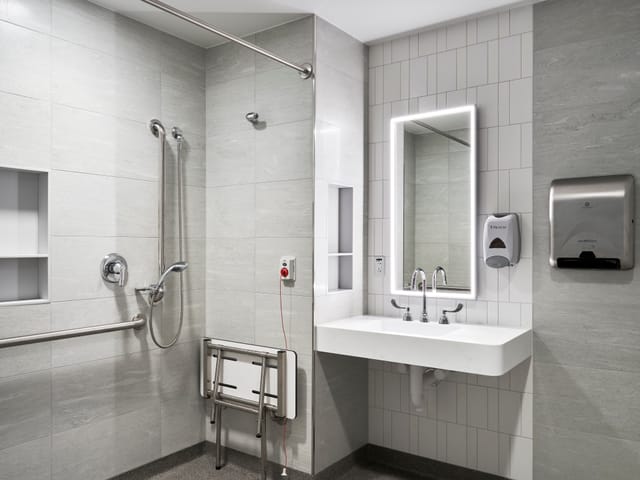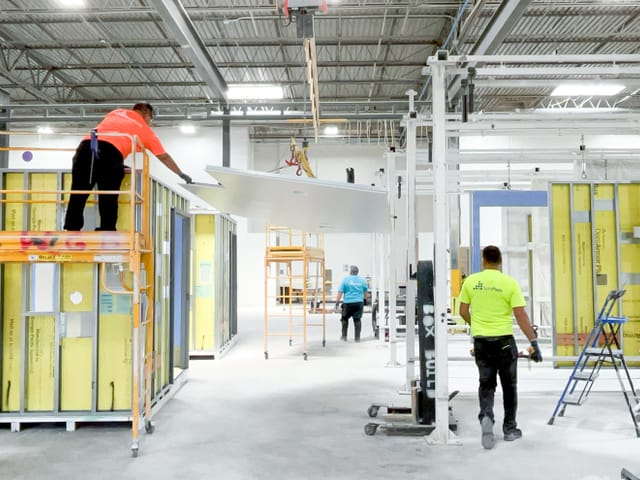“These tasks are usually labor-intensive; for example, just floating the floor would require someone mixing mud in the hallway for days,” Bartley said. “In this case, it’s already done. That means fewer disruptions and a more streamlined process. You’re getting a high-quality product without the usual workmanship issues that come from constantly rotating crews in the field. Since the pods are built in a controlled environment, the result is a better product and a more efficient production process. That’s exactly the direction we want to go.”
Click here to learn more from SmithGroup and SurePods on how implementing prefabricated bathroom pods helped accelerate this fast-paced project.
NAVIGATING CODE AND COMPLIANCE
Delivering prefabricated bathrooms in a healthcare setting required more than design innovation; it demanded deep coordination with regulatory authorities and a clear understanding of California’s stringent building codes. As an HCAI 3 project, the 48X Outpatient Surgery Center had to meet the California Building Code and specific healthcare-related provisions, all while working with UC Davis Health’s building official and fire marshal. This classification allowed for a faster review process than traditional HCAI 1 hospital projects, but still required careful planning around ADA compliance, fire ratings, acoustics, and structural anchorage. UCDH and SmithGroup’s proactive engagement with authorities and early coordination ensured that each unit arrived fully code-compliant, streamlining inspections and reinforcing trust in the prefab approach.
SurePods worked closely with HCAI over six to eight months to develop a standardized inspection process for prefabricated modular bathrooms. This includes material ID inspections at the manufacturing facility, first article inspections for each unique design, and periodic inspections during full production, such as one inspection per 100 pods for a 500-pod project. Final inspections occur onsite to verify mechanical anchorage to the subfloor. Additionally, it’s critical to consider how the pod integrates with the rest of the building, especially transitions in flooring and alignment of wall trims. Details like flush floor transitions using stainless steel strips and matching wainscot trim heights ensure a seamless, code-compliant installation that meets healthcare facility standards.
WHY EARLY DESIGN DECISIONS IS THE KEY TO PREFAB SUCCESS
The shift in mindset required from UCDH and SmithGroup was a major success factor in the project. Unlike traditional construction, where design decisions can evolve over time, the use of SurePods demanded early decisions on finishes, fixture selections, and structural coordination.
“It’s changing the way you think in terms of the stereotypical design process,” said Jackie Lee, lead architect at SmithGroup, highlighting how elements like slab depressions, plumbing rough-ins, and ADA compliance had to be meticulously planned far in advance.
The team worked closely with UCDH and SmithGroup to secure early buy-in on design standards and approvals, ensuring that every prefabricated bathroom unit arrived fully code-compliant and installation-ready. This proactive approach not only streamlined construction but also reinforced the importance of collaborative, front-loaded design in achieving both aesthetic and functional success.
“In terms of a progressive design-build job, which this is, we as architects understood that if the design team took more time designing this and coordinating it during our design phase, it would save time in the field,” Lee said. “And in my understanding, if our job takes a little bit longer or a little more time, but it even saves craft a week or 10 people's time, it is worth it, especially for a project of this size and scale and the schedule in which we had to accomplish it.”









